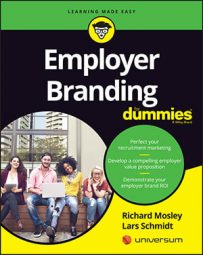When building an employer brand, everyone in the organization needs to push in the same direction with a force of the greatest magnitude possible. With everyone working in unison, brand momentum begins to build, and you begin to win brand advocates outside the organization who put their weight and force behind the brand, moving it ever faster forward.
Branding of any kind works best when everyone agrees and all branding activities align. To achieve this alignment, you need to build your employer brand on a firm foundation.
Aligning your employer brand with business goals and objectives
Just as forces within an organization advance the employer brand, the employer brand is a force that propels the organization forward by delivering the talent needed for the organization to meet its business goals and objectives. As such, it must align with other forces within the organization that share that mission. Specifically, your employer branding strategy must align with the following three strategies that drive the organization’s success:- Business strategy: The employer brand must support the kind of talent capabilities required for the organization to compete effectively. In addition to being fit for talent, it must also be fit for business.
- HR and talent strategy: Your employer brand must either reflect or shape the way HR and talent management operate within the organization to ensure promises are consistently aligned with experience.
- Marketing strategy: The employer brand must reflect corporate and customer brand promises to maintain a general sense of brand integrity.
Using your employer brand to fit in with your other brands
Employer brands never exist in a vacuum; they’re created in the context of the corporate and consumer brands, and, for the most part, they need to align with their corporate and consumer counterparts:- Corporate brand: The reputation your company is seeking to build based on its purpose (the reason for its existence, beyond making money), vision (what it’s striving to achieve), and values (guiding principles)
- Consumer brand: Customer perceptions of the company’s products and services and the brand associations that the marketing team is trying to promote
- Employer brand: The company’s reputation as an employer inside and outside the organization
Prior to launching any employer branding initiative, you need to decide how closely and in what ways you want your employer brand to align with your existing corporate and consumer brands. When the needs of consumers diverge from those of employees, close attention needs to be paid to how the brand is communicated to each target group. For example, “Citi Never Sleeps” made perfect sense to potential CitiBank customers, but would have made a particularly poor call to action for potential CitiBank employees.
Rallying the troops (and leaders) to plan for your employer brand
If you’re in charge of employer branding, part of your job is to make sure everyone’s on the same page, clear about his or her responsibilities, and collectively accountable for doing his or her part. To be successful, you need the backing and support of a wide range of different stakeholders throughout your organization:- Senior leadership: For the brand to be truly authentic and fully embedded in the organization, it needs to be led by the CEO and collectively owned by the entire senior leadership team. The key to getting the leadership team onboard is to make a strong case for employer branding. Senior leadership needs to appreciate the crucial role employer branding plays in securing the talent the company needs to achieve its growth ambitions.
- Marketing and communications: The folks in marketing and corporate communications tend to be very protective of the corporate and consumer brand and resist the notion of a separate employer brand because it can appear to threaten brand integrity. You can make them more receptive to the idea of an employer brand by showing them how it can help to build internal brand engagement and extend the appeal of the brand to external audiences who may not have otherwise considered the brand.
- HR: You definitely need HR on your side. Nobody has more direct accountability for shaping people management processes and more influence over talent strategy. Initially, HR may be reluctant to take on the additional responsibilities associated with employer branding, but making a strong business case and appealing to HR’s desire to keep up with best practice are generally sufficient to win its support.
- Line management: Like HR, line management is likely to be reluctant, at first, to commit time and personnel to employer branding. To rally their support, tailor your presentation to their pain points and aspirations. Highlight the fact that a strong employer brand will help to deliver the kind of talent they need to meet their objectives and ensure they lose fewer key players to competitors.

